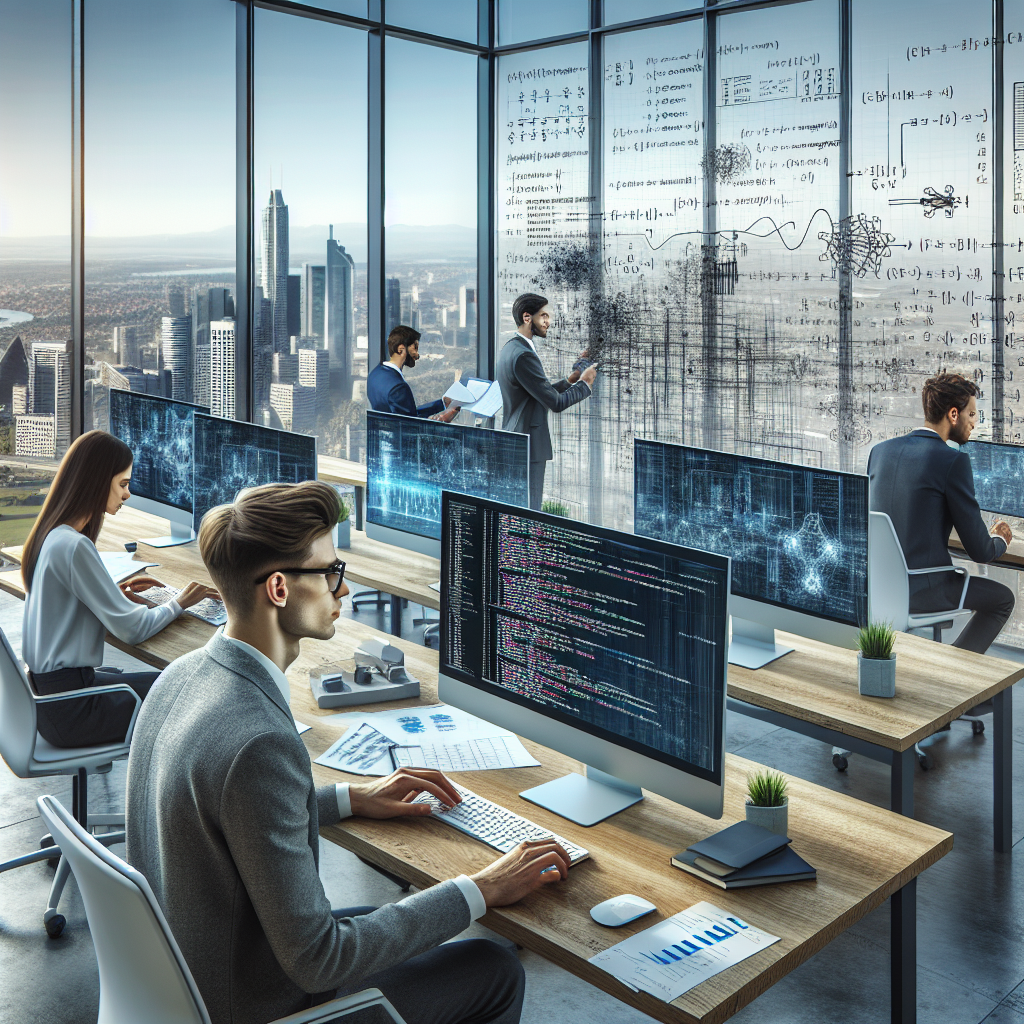Leading Computer Vision Systems, Development of Algorithms, and Software for Machine Vision Solutions

What is Computer Vision and Its Applications? Unlocking Opportunities in Technology

Have you ever wondered how your smartphone can recognize your face in an instant or how self-driving cars navigate through traffic? These remarkable capabilities stem from computer vision, a field of artificial intelligence that allows computers to interpret and understand the visual world. This technology opens up a myriad of opportunities, applicable in numerous industries from healthcare to agriculture, and even security. Let’s break it down!
What Does Computer Vision Represent?
At its core, computer vision represents a system that utilizes algorithms and models to process images and videos, understanding and deducing information from them. Imagine looking at a photograph and instantly knowing what objects are present. Computer vision systems do this and much more, identifying patterns and making decisions based on visual data.
For example, in healthcare, computer vision is revolutionizing medical imaging. By analyzing X-rays and MRIs, these systems can help doctors diagnose conditions with greater accuracy and speed, ultimately saving lives. Research shows that automated diagnosis through such systems can improve diagnostic accuracy by up to 25%. ⭐
Applications of Computer Vision
- ⭐️ Surveillance and Security: Facial recognition systems at airports enhance security efforts.
- ⭐ Autonomous Vehicles: Self-driving cars use computer vision to detect obstacles, road signs, and more.
- ⭐ Healthcare: Algorithms that analyze medical images to identify diseases.
- ⭐ Agriculture: Drones equipped with computer vision can monitor crop health from the sky.
- ⭐️ Retail: Inventory management systems using camera feeds to track stock levels.
How Computer Vision Transforms Industries
The development of algorithms based on computer vision allows businesses to streamline operations and enhance customer experiences. In the retail sector, for instance, computer vision systems can analyze shopper behavior in stores, providing insights into product placement and inventory management. This can lead to a 25% increase in inventory accuracy and significant time savings on manual checks. ⭐
Real-World Success Stories
Let me share a story from a local retail chain that utilized computer vision for their inventory management. They faced challenges with stock discrepancies, which led to frequent shortages of popular products. By implementing a computer vision solution, they were able to automate stock checks. The result? A boost in sales by 15% in just three months, as they always had the right products on the shelves.
How to Order the Best Computer Vision Systems for Your Business Needs
If youre considering incorporating computer vision and its applications into your business, Artivale.com is here to help! Contact us to order tailored systems designed to meet your specific requirements. With over 20 years of experience and a team of professional specialists, we offer all services in one place, ensuring a seamless integration into your existing operations.
Imagine having an entire team dedicated to developing models of computer vision that fit perfectly within your operational framework. From the initial consult to the final implementation, we’re ready to guide you through every step.
Expert Insights
When investing in a computer vision system, consider how frequently your software will need updates to adapt to new requirements or technological advancements. For instance, keeping algorithms fresh and aligned with current data sets will enhance accuracy and performance. Our specialists recommend routine checks at least every six months, based on the frequency of changes in your operational data. ⭐
Ready to revolutionize your business? ⭐ Call us today at [email protected] or visit artivale.com to discover how we can help with cutting-edge computer vision systems specifically tailored for your needs.
| Application | Industry | Impact |
|---|---|---|
| Facial Recognition | Security | Enhanced safety and identification |
| Medical Imaging | Healthcare | Speed up diagnostics |
| Stock Monitoring | Retail | Improve inventory accuracy |
| Crop Monitoring | Agriculture | Optimize yields |
| Image Classification | Manufacturing | Quality assurance |
| Gesture Recognition | Entertainment | Interactive experiences |
| Document Analysis | Finance | Automation of data entry |
| Traffic Analysis | Transport | Improve road safety |
| Speech Recognition | Telecommunications | Enhanced customer support |
| Smart Retail Checkouts | Retail | Faster customer transactions |
Frequently Asked Questions
- What is computer vision? Its a field that enables computers to interpret visual data.
- How is it used in healthcare? Its used for accurate diagnostics through image analysis.
- Can small businesses benefit from it? Absolutely, it can optimize processes and improve customer experience.
- What are common applications? Surveillance, healthcare diagnostics, retail, and agriculture.
- How can I implement these systems? Contact Artivale.com for tailored solutions.
- What industries benefit the most? Healthcare, retail, automotive, and security industries show significant improvements.
- How often should systems be updated? Regular updates every six months are recommended.
- Are there privacy concerns? Yes, its essential to address these while deploying these technologies.
- What is the future of computer vision? It continues to evolve, with broader applications across multiple sectors.
- How secure is this technology? Advanced security features are integrated into systems to protect data.
What Does Computer Vision Represent? Demystifying Its Role in Modern Innovation

Have you ever marveled at how a smartphone can identify a face in a crowded room, or how online shopping platforms can recommend products based on photos? Welcome to the fascinating world of computer vision! This innovative field merges technology and vision, allowing machines to interpret and respond to visual stimuli similarly to humans. Let’s break down what computer vision represents and how its shaping the landscape of modern innovation.
Understanding Computer Vision
At its essence, computer vision is a subfield of artificial intelligence that enables systems to extract information from images and videos. It’s about teaching machines to see and understand the world visually, rather like how we do but with exceptional precision and speed. Think of it as giving a pair of “eyes” to computer systems, enabling them to process visual data in meaningful ways. This is achieved through algorithms that analyze various elements in images, from colors to shapes.
For instance, computer vision plays a crucial role in the automotive industry—self-driving cars use it to identify road signs, pedestrians, and obstacles, allowing for safe navigation. As a statistic, did you know that cars equipped with computer vision technology can reduce accident rates by 40%? ⭐⭐ Clearly, its impact is monumental!
Key Components of Computer Vision
- ⭐ Image Acquisition: This is the process of capturing images through camera sensors and converting them into digital formats.
- ⭐ Image Processing: The stage where algorithms process the images to remove noise and enhance certain features.
- ⭐ Feature Extraction: Identifying key characteristics in visuals, such as edges, textures, and objects.
- ⚙️ Pattern Recognition: The machine learning techniques used to classify and label the features extracted from the images.
- ⭐ Decision Making: Utilizing the processed information to make informed decisions based on the visual input.
Real-Life Applications
The applications of computer vision are diverse and deeply integrated into our daily lives. From the moment you take a selfie to the automated analysis of parking lots, its assistance is everywhere. Let’s dive into specific sectors utilizing this technology:
- ⭐ Healthcare: Computer vision aids in diagnosing diseases through medical imaging. Algorithms can analyze X-rays and MRIs, leading to early detection of conditions like cancer.
- ⭐ Aerospace: In this field, computer vision helps monitor the structural integrity of aircraft by analyzing images of components for any wear and tear.
- ⭐ Agriculture: Farmers use drones with computer vision systems to monitor crops’ health, enabling them to make quick decisions that can save time and resources.
- ⭐ Retail: Virtual try-on solutions at stores allow customers to see how apparel looks from the comfort of their homes, enhancing their shopping experience.
Success Stories: Businesses Embracing Computer Vision
One success story comes from a prominent supermarket chain that adopted computer vision technology in its checkout process. By integrating systems that could scan items and identify products without the need for barcodes, they greatly shortened the checkout time, improving customer satisfaction. The implementation led to a 30% increase in sales during peak hours! ⭐
Why is Computer Vision Important in Todays World?
Understanding what computer vision represents is crucial in today’s tech-driven society. The integration of this technology not only enhances efficiency and accuracy in numerous sectors, but also fosters innovation and improved outcomes. Its influence extends beyond business, reaching into healthcare, safety, and conveniences in our everyday lives.
As a testament to its importance, a study revealed that the market for computer vision is expected to grow to €48 billion by 2028, illustrating its growing relevance. ⭐⭐
Get Involved with Computer Vision Solutions!
If you’re intrigued by the potential of computer vision and want to harness its capabilities for your business, don’t hesitate! At Artivale.com, we specialize in innovative solutions tailored to your unique needs. Whether you’re aiming to enhance operational efficiency or transform your customer experience, our professional specialists can provide comprehensive assistance.
Call us at [email protected] or visit us at artivale.com to learn more about how our custom software for machine vision systems can set you apart from the competition. Together, lets explore how computer vision can propel your business into the future! ⭐
Frequently Asked Questions
- What is computer vision? Its an AI field that enables machines to interpret visual data.
- How does it enhance healthcare? By improving diagnostic accuracy through image analysis.
- Can computer vision be costly to implement? Initial investments may be high, but the ROI is often significant in a short time.
- What industries benefit the most? Industries like healthcare, agriculture, and retail experience the biggest impacts.
- Is it suitable for small businesses? Yes, many small businesses can leverage it for various applications.
- What are the privacy concerns associated with it? Data protection needs to be factored into any implementation.
- How fast is the market growing? The market is projected to grow significantly, highlighting its relevance.
- What technologies are required for computer vision? High-quality cameras and robust processing systems are essential.
- Can it work with different types of data? Yes, computer vision can analyze various data formats, including images and videos.
- How can I learn more about it? Reach out to us at Artivale.com for guidance, resources, and project discussions!
How to Order the Best Computer Vision Systems for Your Business Needs

Are you considering implementing computer vision technology to supercharge your business? With the countless applications and benefits it offers, youre on the right track! However, knowing how to navigate the process of ordering the best systems tailored to your specific needs can be overwhelming. But dont worry—Im here to guide you through it! Let’s break down the steps to ensure you make an informed choice that boosts your operational efficiency and productivity.
Step 1: Assess Your Business Needs
The first step in ordering a computer vision system is to clearly define your requirements. Ask yourself questions like:
- ⭐ What problems am I trying to solve? Are you looking to enhance security, improve quality control, or streamline inventory management?
- ⭐ What scale of operations will the system need to support? Are you a small business or a multinational corporation?
- ⭐ How will the technology integrate with my current systems? Is your IT infrastructure capable of supporting advanced computer vision solutions?
By pinpointing your specific objectives, you can articulate what features you require, like facial recognition, object tracking, or image analysis. This targeted approach will streamline your discussions with potential vendors and make it easier to find a suitable solution.
Step 2: Research Potential Providers
Once you know what you want from a computer vision system, it’s time to research vendors. Look for providers that specialize in software for machine vision systems. Check their websites and read client testimonials. Pay attention to their experience—at Artivale.com, we have over 20 years of experience in building custom solutions, so you can trust your project is in safe hands.
Criteria to Consider
- ⭐ Expertise and Reputation: Look for a company with proven success in developing computer vision applications.
- ⭐️ Customization Options: Ensure they can tailor the solutions to fit your specific needs.
- ⭐⭐ Post-Implementation Support: Can they provide ongoing technical support and training for your staff?
- ⭐ Scalability: Will the system grow with your business needs? It’s important for long-term sustainability.
Step 3: Request and Compare Quotes
After narrowing down your options, reach out to potential providers for quotes. Make sure to ask about:
- ⭐ Pricing Structure: Understand their pricing model—do they charge one-time fees, subscriptions, or per use?
- ⚙️ Included Features: What functionalities come standard, and what will incur additional costs?
- ⭐ Delivery Timeline: When can they implement the system? Quick deployment can be crucial.
Set up meetings or call for consultations to discuss your needs. This not only provides you with quotes but also gives you a sense of each providers customer service and willingness to work with you. Remember, effective communication is key to a successful partnership!
Step 4: Evaluate Demonstrations and Trials
To make an informed decision, requesting demonstrations of the proposed systems is invaluable. This step allows you to:
- ⭐ See the Technology in Action: Watch how the system processes images and responds in real-time.
- ⭐ Assess User-Friendliness: Is the interface intuitive for your team? User-friendly software is essential for effective adoption.
- ⭐ Evaluate Integration: Test how easily it works with your existing systems.
Some providers may offer trial periods for you to assess the softwares performance in real-world scenarios. Take advantage of this! Collect feedback from your team members to see if it meets your expectations. ⭐
Step 5: Finalize Your Order
Once you’ve selected a provider and are happy with the proposed solutions, it’s time to finalize your order. Here’s what to keep in mind:
- ✍️ Contract Review: Carefully read the contract details to avoid any hidden fees or unclear terms.
- ⭐ Implementation Plan: Confirm the rollout process and any necessary training for your staff.
- ⭐ Point of Contact: Establish a direct communication line for support during the implementation phase.
Step 6: Monitor and Optimize
After deploying your new computer vision system, don’t forget to monitor its performance closely. Schedule regular reviews to:
- ⭐ Assess Performance: Are you achieving the desired results?
- ⭐️ Make Adjustments: Optimize the system based on collected data and user feedback.
- ⭐ Plan for Scalability: As your business grows, reassess your needs and upgrade your system accordingly.
Get Started with Artivale.com
At Artivale.com, we understand the intricacies of ordering a computer vision system that perfectly suits your business needs. Our team of professional specialists is here to support you every step of the way and develop customized solutions that reflect your goals.
Don’t wait any longer to transform your operations! Call us at [email protected] or visit us at artivale.com to consult on how to implement cutting-edge computer vision technology in your business! ⭐
Frequently Asked Questions
- How do I determine my businesss computer vision needs? Analyze your current challenges and set clear objectives for what you want to achieve.
- What should I look for in a provider? Consider their expertise, customization capabilities, reputation, and ongoing support.
- Are demonstrations important? Yes! They provide insight into the software’s functionality and ease of use.
- How long does implementation usually take? The timeline varies depending on the complexity of the system and your specific needs.
- What is the best way to optimize my computer vision system post-implementation? Regularly review its performance, collect feedback, and make updates as necessary.
- Is training included with the system? Most providers offer training, but confirm this as part of your contract.
- What are typical costs for computer vision systems? Costs can vary widely based on the features required, starting from around €250.
- Can small businesses also benefit from computer vision? Absolutely! Solutions can be tailored to fit businesses of all sizes.
- How can I ensure data privacy and security? Work with reputable vendors and integrate robust security protocols in your systems.
- Can my system scale as my business grows? Yes, choose a provider that offers scalable solutions suitable for future growth.
Submit your details in the form and our team will personally get in touch with you within the next business day to discuss your needs
